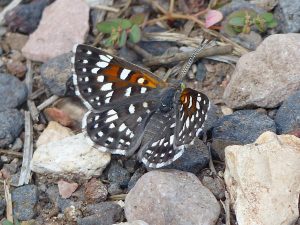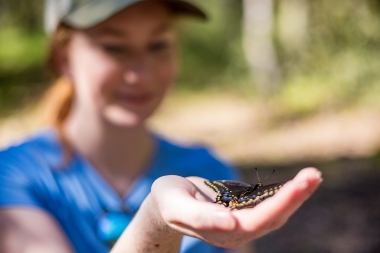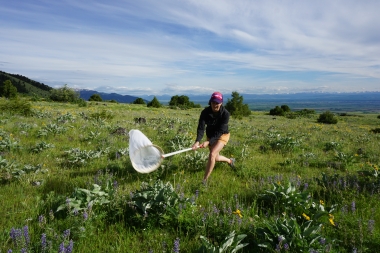Dramatic Decline in Western Butterfly Populations Linked to Fall Warming

By Rosemary Brandt, University of Arizona, College of Agriculture and Life Sciences
Western butterfly populations are declining at an estimated rate of 1.6% per year, according to a new report published this week in Science. The report looks at more than 450 butterfly species, including the western monarch, whose latest population count revealed a 99.9% decline since the 1980s.
“The monarch population that winters along the West Coast plummeted from several hundred thousand just a few years ago to fewer than 2,000 this past year,” said Katy Prudic, an assistant professor of community and data science in the University of Arizona School of Natural Resources and the Environment and a co-author of the report. “Essentially, the western monarch is on the brink of extinction, but what’s most unsettling is they are situated in the middle of the pack, so to speak, in our list of declining butterfly species.”
Declining population groups include butterflies that typically thrive in disturbed and degraded habitats, such as the cabbage white, or Pieris rapae, as well as species with broad migration ranges, such as the West Coast lady, or Vanessa annabella.
The research team sourced more than 40 years of data collected by both expert and community scientists across the western United States to identify the most influential drivers in butterfly declines.
“When we talk about global change, it’s often hard to tease out climate and land-use change because they are happening simultaneously,” Prudic said.
“Our report is unique in covering a wide area of relatively undeveloped land as compared to, for example, studies from heavily populated areas of western Europe,” said Matthew Forister, a biology professor at the University of Nevada, Reno and lead author of the article. “The fact that declines are observed across the undeveloped spaces of the western U.S. means that we cannot assume that insects are OK out there far from direct human influence. And that’s because the influence of climate change is, of course, not geographically restricted.”
The takeaway, Prudic said, is western U.S. butterflies are declining quickly, and autumn warming – not spring warming or land-use change – is an important contributor to the decline.
Fall is the New … Warm
When it comes to seasonal warming, spring gets a lot of attention, but the warming climate affects temperatures year-round. Fall warming trends have been observed in 230 cities across the U.S., with the greatest fall temperature increases found in much of the Southwest.
“In Arizona, for example, the period between September and November has warmed about 0.2 degrees Fahrenheit per decade since 1895,” said Michael Crimmins, a professor and climate science extension specialist in the UArizona Department of Environmental Science. “Fall temperatures have warmed especially fast since the late 1980s and it’s not clear why.”
Declining butterfly populations have been observed in areas experiencing these fall warming trends across the West, according to the report. The authors suggest fall temperature increases may not only induce physiological stress on butterflies but may influence development and hibernation preparation. Warmer fall temperatures can also reduce the availability of food or host plants, and extend the length of time butterflies’ natural enemies are active.
What’s a Butterfly to Do?

In response to recent climate warming, one species in the eastern U.S. has taken flight. In a study published in the journal Frontiers in Ecology and Evolution this week, researchers show an unusually rapid northward shift for the swallowtail butterfly, Papilio cresphontes.
Over the course of 18 years, the swallowtail butterfly moved 324 kilometres north; that rate of expansion is more than 27 times faster than the average organism.
“Butterflies are pretty mobile. The swallowtails we worked on are more on the mobile side of things,” said Keaton Wilson, who completed his postdoctoral research in the College of Agriculture and Life Sciences and is the lead author on the swallowtail article. “The tricky thing is they can move north, but they’re really restricted by their host plants, or what the caterpillar larvae feed on. So, they can fly farther north, but they can’t really hang out long without something for their young to eat.”
Both reports suggest butterflies are struggling to adapt to the changing climate, in urban as well as wild spaces. Conservation, management and restoration of public lands, especially in cooler riparian areas, will be critical to preventing further butterfly declines and extinction, Prudic said. However, it can’t be assumed that protection of wild spaces without careful management is enough to stem the tide, she said.
“What we can do better is develop lands and gather resources we need more sustainably and with more sensitivity to conservation,” said William Mannan, a conservation biologist in the UArizona School of Natural Resources and the Environment.
Mannan points to creative strategies aimed at creating systems of connectivity and minimizing ecological impact, including conservation plans that direct development away from areas of high biodiversity.
Wet urban places, such as botanical gardens and restoration projects like Tucson’s Santa Cruz River Heritage Project, are going to be more important than ever, Prudic said.
“Urban areas that have constant water flow are going to be critical refuges moving forward and likely areas of higher butterfly concentration,” she said.
“The widespread butterfly declines highlight the importance of careful management of the lands that we do have control over, including our own backyards where we should use fewer pesticides and choose plants for landscapes that benefit local insects,” Forister said.
Supporting Pollinators Through Community Science Projects

In tracking butterfly declines, the research team relied on expert and community collected observations from the University of California Davis Shapiro transect, the North American Butterfly Association network and the iNaturalist web platform.
In large-scale biodiversity tracking projects such as these, researchers simply are not able to collect all the data they need on their own. Community science campaigns allow researchers to crowdsource observations and collect more data than they would be able to otherwise, which has been particularly important in filling research gaps created by the COVID-19 pandemic.
“We relied heavily on data from community or community scientists,” Forister said. “Volunteers are generating amazing data these days, and we wouldn’t have been able to study as many locations without decades of hard work from hundreds or maybe thousands of people.”
Prudic said some of the most important data came from remote or hard-to-get-to locations and was gathered by nature enthusiasts and backcountry explorers who participate in the Adventure Scientists community science program.

“By working with community scientists who are already adventuring in biodiverse areas such as high-elevation wildflower meadows, our volunteers are able to submit observations on a large scale,” said Michelle Toshack, associate director of project management for Adventure Scientists. “We work with people from the outdoor community who want to protect the places that they love by contributing scientific data.”
Prudic recommends anyone from a casual backyard observer to an outdoor adventurist consider joining a community science community, such as eBird, eButterfly, iNaturalist or Nature’s Notebook.
“Spending time in nature is restorative; it can be part of the way you take a breath and reflect on some of the amazing things happening all around you,” Prudic said. “And you are helping some scientist on her computer at the kitchen table create knowledge that will help butterflies and their allies now and in the future.”